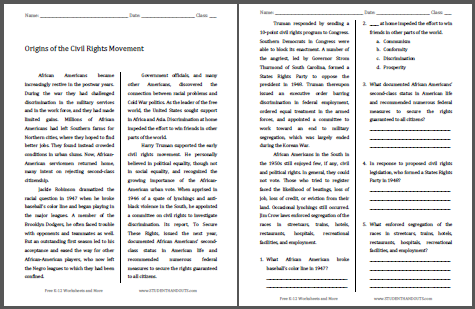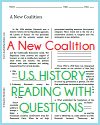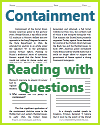| Origins of the Civil Rights Movement Reading with Questions |
|---|
| www.studenthandouts.com ↣ American History ↣ American History Readings with Questions |
 African Americans became increasingly restive in the postwar years. During the war they had challenged discrimination in the military services and in the work force, and they had made limited gains. Millions of African Americans had left Southern farms for Northern cities, where they hoped to find better jobs. They found instead crowded conditions in urban slums. Now, African-American servicemen returned home, many intent on rejecting second-class citizenship.
African Americans became increasingly restive in the postwar years. During the war they had challenged discrimination in the military services and in the work force, and they had made limited gains. Millions of African Americans had left Southern farms for Northern cities, where they hoped to find better jobs. They found instead crowded conditions in urban slums. Now, African-American servicemen returned home, many intent on rejecting second-class citizenship.Jackie Robinson dramatized the racial question in 1947 when he broke baseball's color line and began playing in the major leagues. A member of the Brooklyn Dodgers, he often faced trouble with opponents and teammates as well. But an outstanding first season led to his acceptance and eased the way for other African-American players, who now left the Negro leagues to which they had been confined. Government officials, and many other Americans, discovered the connection between racial problems and Cold War politics. As the leader of the free world, the United States sought support in Africa and Asia. Discrimination at home impeded the effort to win friends in other parts of the world. Harry Truman supported the early civil rights movement. He personally believed in political equality, though not in social equality, and recognized the growing importance of the African-American urban vote. When apprised in 1946 of a spate of lynchings and anti-black violence in the South, he appointed a committee on civil rights to investigate discrimination. Its report, To Secure These Rights, issued the next year, documented African Americans' second-class status in American life and recommended numerous federal measures to secure the rights guaranteed to all citizens. Truman responded by sending a 10-point civil rights program to Congress. Southern Democrats in Congress were able to block its enactment. A number of the angriest, led by Governor Strom Thurmond of South Carolina, formed a States Rights Party to oppose the president in 1948. Truman thereupon issued an executive order barring discrimination in federal employment, ordered equal treatment in the armed forces, and appointed a committee to work toward an end to military segregation, which was largely ended during the Korean War. African Americans in the South in the 1950s still enjoyed few, if any, civil and political rights. In general, they could not vote. Those who tried to register faced the likelihood of beatings, loss of job, loss of credit, or eviction from their land. Occasional lynchings still occurred. Jim Crow laws enforced segregation of the races in streetcars, trains, hotels, restaurants, hospitals, recreational facilities, and employment. Click here to print. Answer Key: (1) Jackie Robinson; (2) C - Discrimination; (3) To Secure These Rights; (4) Governor Strom Thurmond of South Carolina; (5) Jim Crow laws. |
 |  |  |  |  |  |
| Postwar America Worksheets | Postwar America Learning and Study Games |
| Postwar America Outlines and PowerPoints | Postwar America Maps and Pictures |
| Postwar America Miscellany | Postwar America Books and Films |
| www.studenthandouts.com ↣ American History ↣ American History Readings with Questions |














































